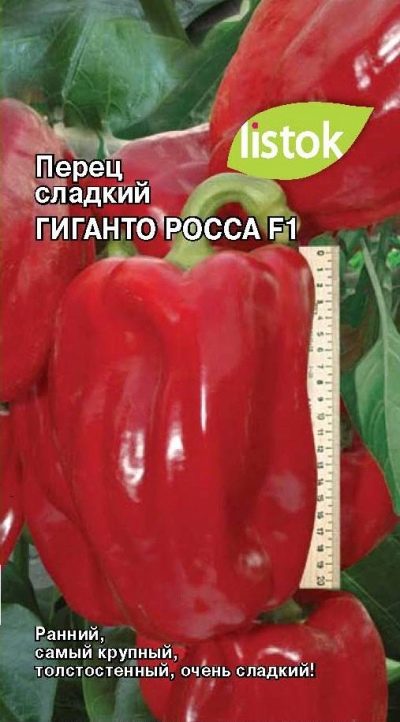
- Bush height, cm: 60-80
- Growth type: medium-sized
- Fruit shape: elongated cuboid
- Fruit weight, g: up to 500
- Fruit color: Dark red
- Ripening terms: early
- Ripening month: July August
- Fruit size, cm: length up to 26
- Yield: high
- Appointment: universal
Giganto Rossa sweet pepper is one of the largest-fruited hybrids grown in Russia. In addition to bountiful harvests, it pleases summer residents with early maturity, amicable ripening, strong immunity that protects against most common diseases. It is a good choice for experienced growers looking to expand their greenhouse plant collection.
Description of the variety
Giganto Rossa is a versatile hybrid suitable for planting indoors or outdoors. Produces bisexual flowers, additional pollination is optional. The bushes are formed according to the half-stem type, their compact size facilitates greenhouse cultivation. The crop tolerates transportation well, has an attractive presentation.
Characteristics of the appearance of plants and fruits
The bushes are medium-sized, 60-80 cm high. The hybrid is distinguished by strong shoots, stems and shoots are strong, durable, withstand a significant load. The leaves are large, ovoid, green.
The fruits of this hybrid are large, up to 26 cm long and weighing up to 500 g. The shape of the peppers is elongated-cuboid, the dark red color of the skin appears upon reaching ripeness. The walls of the fruit are thick, about 7-9 mm, there are 4 seed chambers inside.
Purpose and taste
The fruits are widely used, but are not suitable for whole-fruit canning due to their gigantic size. The pulp of the pepper under the skin is juicy, delicate in consistency. The taste is pleasant, sweet, and there is no bitterness.
Ripening terms
An early hybrid, yields ripe fruits in July-August. It takes 80-90 days from germination to picking peppers.
Yield
Collection volumes reach 10 kg / m2.
Growing regions
The hybrid is thermophilic, it grows well mainly in the southern regions of the Russian Federation. Planting in greenhouses is recommended in central Russia.
Landing scheme
The location of plants at a distance of 50x50 cm is considered optimal.

To get a large and tasty harvest of pepper, you need to take care of the seedlings in advance. When growing pepper seedlings, you need to correctly determine the sowing time, pre-sowing seed treatment, prepare the necessary container and soil.
Growing and care
Plants are grown in seedlings, sowing seeds in late February or early March. They can be transferred under the film in mid-May, in open ground - 4 weeks later. On average, plants are ready for transplanting 55 days after germination. Outdoors, Giganto Ross peppers need extra wind protection.
Plants require periodic watering, no more than 2 times a week; during periods of drought, it is carried out only in the evening hours, increasing the amount of moisture supplied. On fertile soils, additional fertilizing is optional, but during flowering and fruiting, potassium-phosphorus supplements can be used.
Plants need compulsory pinching. The top is tied up as it grows. The royal buds are removed. Lead the bush in 2 stems to get the most bountiful harvest.

To harvest a tasty and rich harvest of pepper, you need to comply with all the conditions of agricultural technology, and proper care begins with planting plants. Before planting pepper in open ground, it should be prepared.It is also important to take care of the seedlings and planting space in advance.



Soil requirements
Plants need a fertile breeding ground. The soil is preferable black earth, rich in humus, moist.

For good growth of pepper bushes and active fruiting, you need to regularly apply mineral and organic fertilizing to the soil. It is necessary not only to choose the right formulations, but also to use them at the right stage in the development of culture. The frequency of top dressing is always individual. It depends directly on the composition of the land on your site. The poorer the soil composition, the more often you will need to feed the pepper.
Required climatic conditions
For full ripening, the fruit requires a lot of sunlight and heat. With their lack, the growth and development of the bushes slows down.
Disease and pest resistance
Despite the general high rates of immunity, Giganto Rossa requires mandatory comprehensive protection against fungal diseases and infections. Plants are especially vulnerable to them in cold climates with prolonged periods of rain.

Pepper is one of the most common vegetables in home gardens. This culture is quite stable and unpretentious. However, under certain conditions, this plant can suffer from infections and harmful insects. Before treating peppers for diseases or pests, you need to find out the cause of the problem, otherwise the treatment may be ineffective.
Review overview
Giganto Rossa is a pepper hybrid highly appreciated by summer residents. In their opinion, the germination rate of plant seeds is close to 90%. The seedlings turn out to be strong and beautiful, responds well to care, but needs additional lighting at early sowing, otherwise the stems will stretch out. There are few barren flowers on the bushes, most summer residents prefer to remove them so that the plant directs its forces to the formation of fruits.
Reviews of the fruits are also impressive. They really turn out to be large, with a beautiful pod shape. The taste is highly rated. The fruits are used in salads, suitable for stuffing. Giganto Rossa keeps well in freezing, does not deform after thawing.
Summer residents note that in the conditions of the Urals and Siberia, the peppers on the bushes do not have time to ripen completely. They have to be cut unripe.Also, amateur vegetable growers mention that the shape of the peppers may differ from the declared one, and it will not work to get a re-harvest from the harvested seeds of this hybrid.





















































































